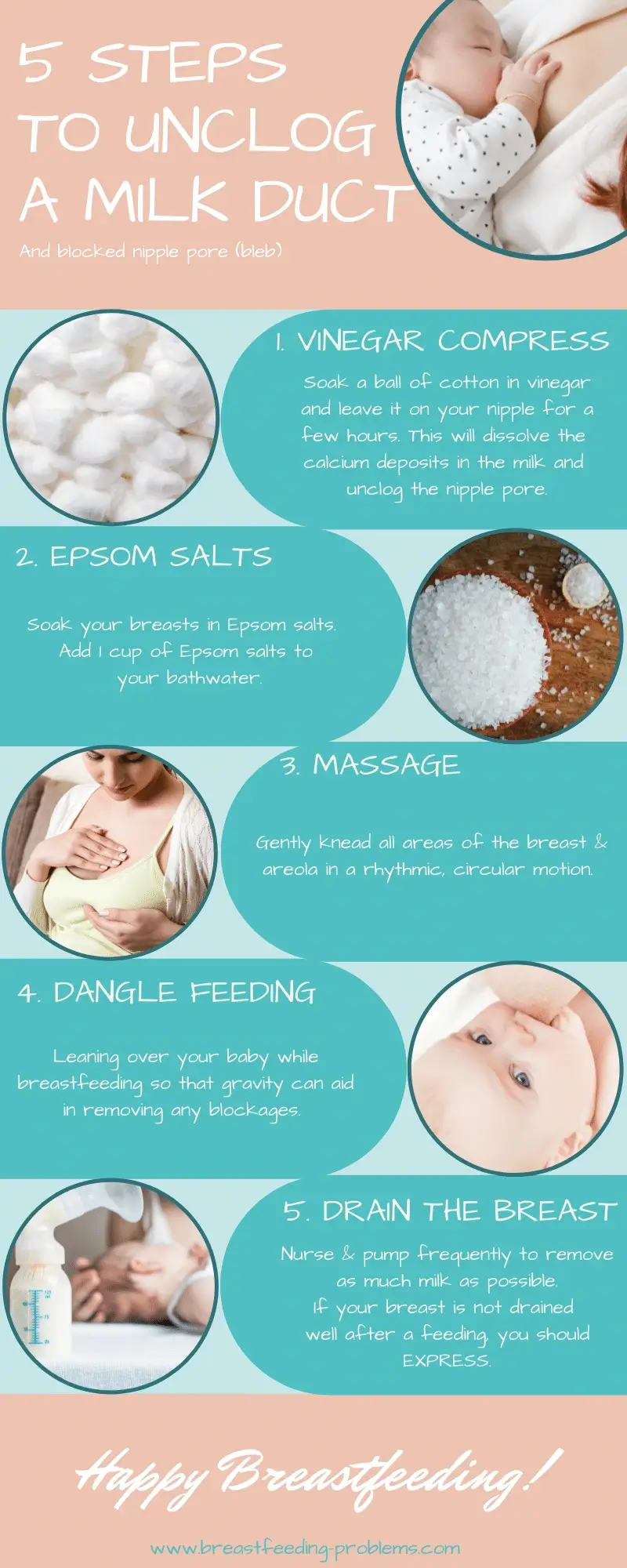Dangle Feeding - Step-By-Step How to Easily Unclog Milk Ducts
Clogged ducts can block the path of milk, which can cause pain, inflammation and may lead to a breast infection and even an abscess. It is imperative that a mother is informed about ways to keep her milk flowing sufficiently and how to quickly get rid of any blockages that may occur.

Table of Contents
- What is dangle feeding?
- How does dangle feeding work?
- How to dangle-feed
- Dangle feeding video
- Treating a bleb using dangle breastfeeding
- Why use breast massage before dangle feeding
Clogged ducts can block the path of milk, which can cause pain, inflammation and may lead to a breast infection and even an abscess. It is imperative that a mother is informed about ways to keep her milk flowing sufficiently and how to quickly get rid of any blockages that may occur. Here we discuss exactly how to do just that with the help of dangle feeding and other methods.

Something worth mentioning that may help if you have recurrent plugged ducts is sunflower lecithin. Lecithin can help to prevent and treat plugged ducts blebs, and mastitis.
What Is Dangle Feeding?
It's not the most comfortable breastfeeding position, but it helps to unlodge milk during a bout of plugged ducts or even mastitis. When you dangle feed, you are leaning over your baby so that gravity can aid in removing any blockages. If you are going to take advantage of this position, you need to ensure that your baby still has a good latch for effective milk transfer.
If you have hard, swollen, engorged breasts, dangle feeding can help remove more breast milk and therefore soften the breast and relieve pain.
“Breastfeeding reminds us of the universal truth of abundance; the more we give out, the more we are filled up, and that divine nourishment – the source from which we all draw is, like a mother’s breast, ever full and ever flowing.” - Sara Buckley

Breastfeeding Class for Moms
Many mothers worry about breastfeeding not working for them, the pain and struggles associated with latching, and concerns about milk supply. The course tackles these fears head-on.
The course offers 13 easy-to-watch lessons, providing a step-by-step guide to breastfeeding.
How Does Dangle Feeding Work?
No pump can match up to the sucking skills of a baby, add gravity and you have a strong force that helps to pull the milk down, making it even easier for your baby to drain the breast. Dangle breastfeeding is often used as a preventative measure against blockages too.
While taking advantage of the dangle feeding position, It is essential that a mother uses other methods to help remove blockages, too, such as using an Epsom salts soak and heated compresses. See treating clogged milk ducts. The angle and position of your baby at the breast during dangle feeding is so different from any other breastfeeding position that it might be just what you need to get things flowing more freely. Some mothers have claimed that it has helped them stimulate a let-down and even increase their milk supplies. Again, a mother may find that her baby latches more efficiently using this position than others - it's worth a try, even if it's not the most comfortable breastfeeding position!

How to Dangle-Feed
Dangle feeding can be done while the baby is in your lap, on the bed, or on the floor. You can stand on all fours while your baby is on their back. You can alternatively dangle-feed while sitting; kneel up over your baby to ensure that your breasts are hanging while nursing; this helps gravity get things flowing. You might need to use some cushions or pillows to keep your back or shoulders from straining.
What Is Dangle Pumping?
Dangle pumping is a technique used to improve milk flow during breast pumping by utilizing gravity. The method involves sitting in a comfortable position and leaning forward so that the breasts hang down with the nipples pointed toward the ground. The flange or breast shield is then positioned correctly, and pumping begins as usual. This technique may also be helpful in clearing clogged ducts. To help with comfort during the pumping session, you may use a bolster or pillow to lean over, rest your feet on a stool, or use a large towel for support. After a c-section, leaning forward with your elbow and forearm across your knees may be more comfortable.
Dangle Feeding & Breast Massage Go Hand-In-Hand
Breast massage will soften the breast tissue and loosen the milk, making dangle feeding double as effective.
Massage helps to improve lymphatic drainage. Fluid build-up is common in breast tissue and will cause swelling and water retention. Massage and dangle feeding used simultaneously can help to prevent this extra fluid build-up and, therefore, prevent other issues. 'Breast massage may have effects on relieving breast pain, decreasing breast-milk sodium, and improving newborn suckling. Breast massage can be used to solve breast problems.' (1)
What Is a Bleb?
A milk blister or bleb is a small yellow or white spot found on the nipple pore opening; this indicates a blocked pore that can sometimes lead deeper into the breast.

How Do You Unclog Milk Ducts With Dangle Feeding?
5 Steps to Easily Unclog a Milk Duct
- Make a paste of bicarb and vinegar and put it on a cotton pad. Leave the cotton pad on your nipple for a few hours. This will dissolve the calcium deposits in the milk and decrease the size of any nipple blockages (aka blebs).
- After this, you can soak your breasts in Epsom salts. Add 1 cup of Epsom salts to your bathwater.
- Gently knead all areas of the breast in a rhythmic circular motion. If the bleb has not opened on its own yet, you can puncture it with a sterilized needle.
- Allow your baby to dangle feed. Leaning over your baby while breastfeeding so that gravity can aid in removing any blockages.
- Drain the breast - Nurse and pump frequently to remove as much milk as possible. If your breast is not drained well after feeding, you should express.
References
1. https://synapse.koreamed.org/DOIx.php?id=10.4040/jkan.2011.41.4.451
Effects of Brest Massage on Breast Pain, Breast-milk Sodium, and Newborn Suckling in Early Postpartum Mothers
Sukhee Ahn,1 Jinhee Kim,2 and Jungsuk Cho2
1 Associate Professor, College of Nursing, Chungnam National University, Daejeon, Korea.
2 Doctoral Candidate, Nursing Major, Graduate School, Chungnam National University, Daejeon, Korea.
Header photo by Filip Mroz on Unsplash

